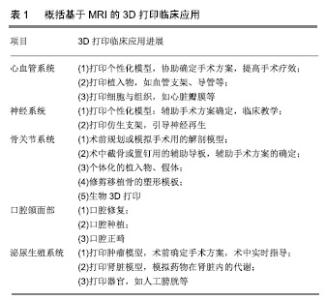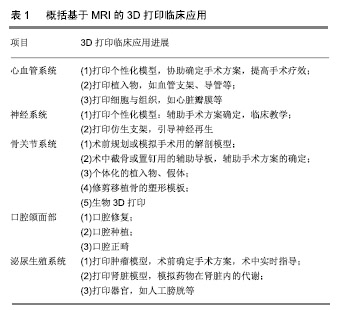Chinese Journal of Tissue Engineering Research ›› 2019, Vol. 23 ›› Issue (30): 4897-4904.doi: 10.3969/j.issn.2095-4344.1423
Previous Articles Next Articles
Magnetic resonance imaging-based 3D printing technology: advantages and prospects in clinical application
- The Third Affiliated Hospital of Southern Medical University, Guangzhou 510000, Guangdong Province, China
-
Received:2019-05-20Online:2019-10-28Published:2019-10-28 -
Contact:Zhang Xiaodong, Associate chief physician, The Third Affiliated Hospital of Southern Medical University, Guangzhou 510000, Guangdong Province, China -
About author:Wang Jian, Master candidate, The Third Affiliated Hospital of Southern Medical University, Guangzhou 510000, Guangdong Province, China -
Supported by:Science and Technology Planning Project of Guangdong Province, No. 2017B090912006 (to ZXD)
CLC Number:
Cite this article
Wang Jian, Zhang Xiaodong. Magnetic resonance imaging-based 3D printing technology: advantages and prospects in clinical application [J]. Chinese Journal of Tissue Engineering Research, 2019, 23(30): 4897-4904.
share this article

2.1 基于MRI的3D打印技术的临床应用 2.1.1 心血管领域 心血管疾病是临床常见病及多发病,临床致死率、致残率较高,快速准确的对心血管疾病做出正确的诊断,有助于疾病的及时治疗,进而降低心血管疾病患者病死率,延长寿命,提高生活质量。先进的成像方式可以为复杂心脏病患者提供重要的解剖及空间信息,近些年来,随着心脏磁共振技术的发展,目前磁共振成像技术可获得心血管形态、功能、心肌灌注及活性等信息,可广泛应用于心血管疾病的诊断及治疗[10]。二维成像在表达真实的三维关系方面受到了限制。而3D打印技术的应用提供了心脏物理模型,克服了2D平面图像的限制。心脏磁共振成像具有多平面、多参数、多序列成像及较高的软组织分辨率等优势,被称为无创评估心脏结构和功能的“金标准”[11]。国内外多使用CT检查获得医学数字成像和通信数据建立心脏3D模型,而胡立伟等[12]研究发现,磁共振三维稳态自由进动序列(3D-SSFP)构建的心脏3D模型更清晰地显示右房内隔膜梗阻的空间位置,能有效地辅助诊断并应用于优化手术方案,为先心病患者提供精准化的治疗,降低在CT扫描过程中电离辐射给人带来的伤害;Farooqi等[13]对1例三尖瓣下移畸形患者行心脏磁共振成像检查,并以此为基础打印3D模型,他们从三维模型外部可简单清晰的观察到严重扩张变形的右心室,从内部可以看到三尖瓣瓣叶移位到右室流出道,也有助于规划心室辅助装置流入和流出套管的放置;Valverde等[14]对1例15岁主动脉弓发育不良患者行磁共振检查,并打印三维模型,该模型可用于模拟支架介入治疗,并评估最佳支架位置、大小和长度,3D打印模型与MRI、X射线血管造影图像吻合良好[平均偏倚和标准偏差为(0.36±0.45) mm],三维打印模型能准确地复制患者的解剖结构,有助于制定主动脉弓发育不良血管内支架置入术的计划;Ahmadian等[15]对1例主动脉夹层患者利用MRI技术精确打印出3D模型,通过对比4D Flow MRI技术对患者血流动力学的精准量化,证明该模型可以用于大动脉疾病的血流动力学评估。心脏磁共振扫描可以清晰显示室壁结构及重要心脏大血管的解剖、心脏血流动力学改变、心脏运动及心肌活性,有助于医生对心脏疾病,如冠心病、先天性心脏病、心脏占位性病变、心包疾病等的诊断,同时心脏磁共振为打印心脏模型提供了一个重要手段,3D打印的实体模型可以更为直观显示心脏的三维解剖细节,更清晰的显示心脏大血管的走行,更好的辅助医生了解病变性质、确定手术方案、模拟手术,但是基于磁共振图像信息所打印的3D模型对心肌的病理学改变无法做出直观的显示,尚需要进一步探究,进而发挥心脏3D打印实体在心血管领域的作用。 2.1.2 神经领域 神经系统主要包括中枢及周围神经系统。中枢神经系统疾病种类繁多,包含多种发病机制,临床上发病会对患者身体健康造成较为严重的影响,严重时甚至会危及患者生命安全,因此早期识别病变并作出重要诊断对于患者预后尤为重要;周围神经系统结构纤细走行复杂,病变会造成躯体功能障碍,严重者将引起瘫痪及呼吸衰竭,尽早的对疾病做出诊断,可有效的避免神经系统疾病的进展。MRI检查对软组织的敏感度高,可清晰的显示神经系统病变组织与周围正常组织之间的解剖关系,对识别病变组织的性质及切除范围具有重要的指导意义。Marks等[16]运用MRI获得患者的医学数字图像,进而产生3D打印的脑和海马的模型,清楚的显示由阿尔茨海默病引起的脑进行性退化的过程。Lin等[17]对2例鞍区肿瘤和1例听神经瘤的术前影像学资料进行回顾性分析。在此基础上,采用3D T1-TFE(Turbo Field Echo,快速场回波序列)和弥散张量成像对颅内神经进行可视化。使用Mimics软件对肿瘤周围颅底区域进行三维重建,打印三维实体模型,模型可以提供脑组织、血管、颅神经、肿瘤等相关结构信息。van de Belt等[18]为多名成人胶质瘤患者进行功能磁共振成像和弥散张量成像检查,将其作为术前检查的一部分并打印出实际尺寸的3D模型,该模型提高了患者对其病情、治疗方案和风险的了解,有助于医患双方的沟通。兰青等[19]运用MRI及功能MRI打印颅脑模型,可清晰直观的显示鞍区各手术间隙的大小,有利于术前手术间隙的选择,颅脑肿瘤模型可清晰的显示传导束及功能区的空间关系,体现出头颅标本无法显示的功能区及传导束位置,有利于功能区的保护。磁共振由于其多参数、多序列成像及组织分辨率较高等优势,可多臂丛及腰骶丛等周围神经清晰显示,但目前3D打印尚未在周围神经系统领域等到广泛应用。神经系统疾病种类繁多,生理机制复杂,临床诊断特异性需求高。多参数MRI技术可以对疾病的类型做出准确的诊断,并制定出合理有效的治疗方案,有研究证明MRI检查对于神经系统病变具有较高的应用价值,可在神经系统疾病相关检查中优先考虑,从而提高其诊断效果。基于磁共振的神经系统的3D打印,除可以清晰显示神经系统正常解剖、病变的形态及边缘,还可以更精确的显示病变位置与周围组织的三维结构关系,有助于协助医生做出正确的诊断,可以有效的辅助确定手术治疗方案及模拟手术,明显的缩短了手术时间及不必要的手术并发症,提高手术的安全性。 2.1.3 骨关节领域 骨肿瘤与其他系统肿瘤相比发病率相对较低,是临床上较为常见的病症,骨肿瘤的类型较多,患者早期通常无明显症状,发现时常为晚期,这将严重影响患者生命健康。因此对骨肿瘤应尽早诊断并进行及时有效治疗。近些年来,随着新辅助化疗的发展,骨肿瘤患者一般采取保肢手术,如何精确的切除肿瘤组织、对缺损组织进行修补是当前临床医生所面临的重要问题。来源于医学影像数据的3D打印技术可以直观、准确的将肿瘤及周围组织进行展示,有助于临床医生按照病变情况进行数字化手术设计,达到预期的手术效果。曲扬等[20]通过运用CT及MRI图像配准并联合3D打印,使得患者及医生准确判断肿瘤安全边界,设计出个性化3D打印假体及手术导板、模拟手术方案,对于难治性骨盆肿瘤术前规划具有重要意义。Guenette等[21]报道了利用MRI可视的3D打印模型冷冻消融治疗C7椎弓根骨样骨瘤和L1椎板成骨细胞瘤,利用该技术可以经皮准确定位病变部位。孔金海等[22]对31例脊索瘤整块切除的病例进行了回顾性研究,他们运用MRI检查资料制定包含累计骶骨肿瘤组织(包块周围血管、神经)的3D打印模型用于术中指导骶骨脊索瘤切除方法是有效的,而术前3D打印技术有助于安全而有效地辅助术中完整延边界切除骶骨脊索瘤,减少毗邻的大动、静脉及周围神经组织损伤;其次,术前借助此模型可有效地与患者和家属交流沟通,评判手术风险,降低患者过高的期望值,为潜在的医疗纠纷隐患扫清了障碍。为了实现骨肉瘤精确切除,Ma等[23]利用计算机辅助设计技术,在MRI的基础上,设计出针对特定患者的骨肉瘤切除引导模板。然后采用3D印刷技术制作导向模板,引导模板用于指导骨肉瘤手术,使用3D打印导向模板能够更精确地切除肿瘤骨并置入假体,减少出血,缩短手术时间和减少术中辐射暴露,而且术后患者恢复良好。影像学检查通常能够准确地判断肿瘤的性质、种类及范围,还可以对治疗方案的确定提供重要的依据。而磁共振检查通常可以辅助确定肿瘤内部成分、肿瘤的性质,同时可以显示原发骨肿瘤对周围肌肉、神经等软组织侵犯程度,对确定手术方案尤为重要。而以磁共振数据为基础的3D打印,既可以直观显示病变范围及周围组织结构,还可以辅助医生确定手术方案、模拟手术进行及加强与患者沟通等方面具有重要意义。 在除骨肿瘤以外骨关节的其他领域,3D打印技术也扮演者重要的角色。众所周知,全身各关节结构复杂,常规X射线及CT检查仅可显示构成关节各骨结构的完整性、有无周围组织侵犯,而对于关节内韧带、半月板及关节囊显示欠佳,而关节造影检查有一定的创伤性,不适合广泛应用于临床上。刘帅等[24]应用MRI对需要进行人工全膝关节置换患者进行膝关节MRI检查,磁共振检查数据可以清晰的显示膝关节软骨层的厚度,为手术的成功提供了可能,而根据患者个性化解剖数据,设计的膝关节手术辅助导板避免了扩髓,提高了截骨的精准度、缩短了手术时间、减少了术后引流量,获得了较好的术后精确度及临床效果,且稳定性较好;另有研究证明,3D打印前叉韧带损伤患者手术导板,术中手术导板可与膝关节各骨性结紧密贴合,术后韧带重建较传统手术组更接近前交叉韧带止点解剖位置,下肢力线偏移角度减小[25-26]。总之,MRI软组织分辨率较高、多方位、多参数、多序列成像特点能够对隐匿性骨折与半月板、韧带、关节软骨的损伤情况进行直接显示。现在磁共振检查膝关节损伤的应用频率较高,能够对治疗效果和预后做出正确评估。术前对膝关节损伤患者进行MRI检查,既可以提高膝关节损伤诊断的准确率,同时可有效避免对患者进行有创检查,减轻患者痛苦。而基于磁共振图像数据进行3D打印关节模型,可以将二维图像转化为三维实体模型,可以是医生更好的了解针对患者的个性化解剖模型,这有助于辅助医生模拟手术的进行。 总之,3D打印在骨关节领域应用广泛,如打印骨骼模型、手术辅助导板、个性化金属植入物等,而且研究证明3D打印安全性在短期随访中已显示出较为良好的临床疗效。 2.1.4 口腔颌面部医学领域 口腔颌面部解剖结构较为复杂,影像学检查为颌面部疾病的诊断及治疗计划提供了非常有价值三维影像,可以充分显示颌面部的立体解剖结构。在口腔颌面部肿瘤手术期间,部分或完全切除上颌骨将会导致口鼻部组织缺损,致使颌面部功能障碍[27]。因此,确定手术切缘及手术方式在颌面部手术中尤为重要。MRI是检查颌面部肿瘤及确定术前分期的最佳方法,3D打印下颌骨切割指南是通过CT数据进行三维重建的,但是肿瘤边缘难以在CT上可视化,而在MRI扫描中清晰可见。van Eijnatten等[28]证明利用UTE序列进行骨骼MR成像是产生不同形态的下颌骨STL模型的CT成像的可行替代方法,因此适合于外科手术规划和添加制造。Reinbacher等[29]对颌面部骨质进行磁共振及断层扫描成像并进行三维重建,发现在MRI数据上生成颌面骨的3D模型在技术上是可行的,且MRI可以代表用于颌面外科术前规划过程中三维模型替代来源,基于MRI的下颌模型就可以进行模拟肿块切除、确认手术方法,而不需要额外辐射暴露。张海等[30]通过MRI对7例复杂的鼻颅底肿瘤患者行MRI检查,成功重建了三维虚拟模型,并打印出1∶1的3D实体解剖模型,模型可清晰显示颅骨、肿瘤及其与毗邻血管的位置关系。Mourits等[31]对1例6岁眼眶囊肿的患者行MRI检查扫描显示囊肿引起眼眶右侧结构扭曲,而基于MRI的3D打印能够精确准确显示眼眶囊肿及邻近骨结构,进而规划手术方法,设计并个性化定制眶底的植入物。同时,3D打印技术逐渐应用于口腔医学的众多领域,如口腔修复及口腔正畸等多个学科领域。MRI检查由于其软组织分辨率高、多方位成像等优势,清楚显示口腔颌面正常解剖及病理改变,可以协助医生了解病变性质、范围、形态及与周围组织的关系,使得医生对颌面部立体结构有更加直观的了解,对于治疗方法选择及根治范围的确定有指导意义,此外,3D打印可作为替代植入物的重要来源。3D打印技术有望进一步改善口腔医学领域疾病的治疗。 2.1.5 泌尿生殖领域 对于泌尿生殖系统疾病,医生通常需要了解患者病变位置进而确定治疗方案,指导外科手术的进行,而影像学检查是提供这些信息的必要手段。MRI检查可以提供的优越组织特征,因此在显示子宫、前列腺及肾脏等具有一定的优势。Sayed Aluwee等[32]对5例诊断为子宫内膜癌患者进行MRI检查,通过对源数据图像进行半自动分割建模并打印,模型可清晰显示子宫、子宫内膜、肿块及血管,外科医生和患者的反馈表明,该模型有助于医生向患者解释疾病情况,获取子宫与肿瘤位置关系等信息。在本次调查中,与患者对肿瘤情况的了解比,外科医生的经验并没有受到显著影响。Lindegaard等[33]以1例晚期宫颈癌的病例为例,该病变累及膀胱后壁及盆腔壁,就基于MRI的3D打印阴道模型,研究证明三维打印模型为宫颈癌的个体化宫颈癌腔内联合组织间插植近距离放射(IC/IS-BT)开辟了一条新的、快速、廉价的途径,即使在阴道狭窄的条件下,3D打印阴道模板也很容易操作。Baek等[34]对1例28岁阴道流血诊断为早期子宫颈癌的患者进行MRI检查并打印三维模型,模型可以清晰显示子宫、宫颈、肿瘤及内出血情况,模型可以帮助外科医生评估宫颈内肿瘤的范围及其与宫颈内缘的距离以确定手术方案,帮助患者更好地了解自己的病情并做出决定,可以有效降低残余肿瘤的发生率、切除边缘的阳性率和不必要的根治性切除,最终改善手术和生存结局。3D打印模型给妇产科医生更加直观的实体显示,使手术更精准、更个体化,进而实现手术效果的最优化。Wu等[35]应用体内MRI数据为基础设计前列腺癌患者专用模具用以固定前列腺全切后的组织,这个模具可以良好的约束前列腺形态及全组织病理学切片的位置,模具固定的病理组织可以实现超高空间分辨率MRI和多组分定量扩散磁共振;Shin等[36]通过MRI扫描建立前列腺癌患者全前列腺半透明3D模型,模型可以帮助外科医生很好地识别肿瘤的位置,大小和范围及与前列腺包膜和神经血管束的接近程度,对于保留神经的机器人辅助根治性前列腺切除术具有重要意义,对于前列腺癌的神经保留切除术或消融治疗是非常有用的辅助手段;Wake等[37]应用脂肪抑制梯度回波T1加权成像,成功打印肾脏三维模型,模型可清晰辨认肾肿瘤、肾皮质、肾髓质、肾动脉、肾静脉以及集合系统。基于磁共振的特定患者3D打印模型可以提高外科医生对特定解剖的理解,更直观的显示病变位置三维结构,可有效的促进手术计划的制定,减少手术时间,并改善患者的预后。 2.1.6 其他 基于MRI的3D打印除应用于心血管、神经、骨关节、泌尿生殖领域外,目前也可应用于乳腺外科,Rao等[38]对8例乳腺癌患者在保乳手术前行俯卧位MRI检查,获得了肿瘤大小,形状和空间位置的信息并打印3D模型,然后将该模具灭菌并用于指导术中乳腺切除。术后病理证实所有患者手术切缘均为阴性,该研究证明,3D打印模具引导保乳手术是可行和安全的,该技术降低了保乳手术的边缘阳性率和二次操作的风险。目前基于MRI的3D打印在乳腺外科的应用较少,有望进一步研究。 2.1.7 临床应用概况 见表1。 2.2 基于MRI成像的3D打印在临床教学中的应用 运用3D打印的生理或病理模型,不仅可以为学生展示生动形象的教学内容,而且因为其成型精度高、分辨率高、可重复性好等优点,在医学领域临床教学及培训中应用广泛。在当前使用尸体标本进行医学专业和医学相关专业培训的背景下,实体解剖教学倍受社会争议,而运用3D打印解剖学标本,可以很大程度上解决许多安全及伦理问题,而且与尸体模型相比,成本效益更高[39]。 脑部MRI是儿童神经系统发育异常辅助诊断的重要影像学基础。李世俊等[40]运用多模态MRI建立神经环路模型,并以此为基础对研究生进行教学,与传统教学组相比较,3D打印教学组在脑部解剖知识的把握程度、脑部功能分区理解程度、弥散张量成像辅助诊断作用理解程度、儿童神经系统发育障碍特征理解程度及临床康复干预中的MRI定位作用方面较传统组有明显优势,能够使学生较好地掌握儿童脑部MRI相关的教学内容。由于颅底结构复杂,经鼻内窥镜颅底手术对于缺乏经验的神经外科医生提出了挑战。Zheng等[41]对42名健康男性志愿者的MRI扫描图像进行处理,并打印出多材料、多颜色的三维模型,以李克特量表为基础,评估模型保真度、解剖学教育及手术训练效果,研究发现,3D打印模型是一种经济、实用、高保真的模型,并且在经鼻内窥镜手术的解剖学教育和操作训练方面有巨大的潜力。 肛周瘘管是难以理解及教导的疾病,而了解瘘管的形态及周围累及括约肌的数量是了解治疗方案及手术成功的关键。Sahnan等[42]对瘘管及周围结构进行频谱衰减反转恢复MRI并对图像进行分割打印,有助于对括约肌复杂结构进行良好的评估,有助于与患者沟通及增强训练。陈为坚等[43]运用磁共振扫描所获得图像进行膝关节疾病模型的打印,为骨科研究生更为生动和直观地提供膝关节相关病例的解剖形态,让学生不仅学好疾病的病因、诊断及治疗,还能更好的让其准确掌握相关病变的解剖部位、空间结构、几何形状及与周围重要组织器官之间的位置关系,与此同时,还可以满足手术需求并进行模拟操作练习,让学生发现理论方面没有的细节,加深学生对疾病及解剖的进一步理解。虽然3D打印可以提升学生对解剖和疾病的认知,有利于理论与实践相结合,但是由于3D打印本身的局限性,如模型制造费用较为昂贵及特殊的制造设备等,限制了其在临床教学中的应用。 2.3 3D生物打印 3D生物打印技术是3D打印最热门的研究领域,在功能组织和器官的制造方面具有广阔的应用前景。陈以胜等[44]运用7.0T磁共振仪扫描3只雌性大鼠并获得T8-10节段脊髓截面位置和形状图像,研究发现运用MRI所获得的数据打印出的大鼠脊髓仿生支架同正常脊髓形态及大小相近,未来将有望应用于脊髓损伤的修复。生物制造巧妙的将生命科学、材料科学及制造科学融合起来,为患者提供了以自身细胞及其他材料构成的“生物墨水”为基础的设计和制造并用于替换病变组织和器官的结构的方法[45-46]。目前被认为是能够推进和加速组织再生医学领域发展的一个重要手段,已经应用于多种组织的生成和移植,包括皮肤、骨骼、血管移植、气管夹板、心脏组织和软骨结构[47-48]。原理同普通3D打印相同,打印方法主要包括仿生学、自主组装和微型组织构建模块,它能够准确控制组织和器官的微观和宏观结构,最终打印出具有生物学功能的组织和器官,可被应用于组织工程、再生医学、药代动力学和其他生物学研究中活组织和器官的重建[49]。然而,虽然3D生物打印有着广阔的发展前景,但是由于细胞对生存环境的要求非常苛刻,所以适于3D生物打印的材料很有限,这限制其发展。 2.4 基于MRI成像的3D打印不足与展望 由于MRI多平面、多参数、多序列成像以及较高软组织分辨率等特点,使其在3D打印建模中发挥着重要的作用。但目前基于MRI的3D打印技术尚存在以下局限性:①磁共振检查费用相对较高;②MRI对呼吸系统疾病的显示不佳,且对体内铁磁性植入物、心脏起搏器、幽闭恐惧症等患者无法进行MRI检查;③MRI的优势是软组织及功能成像,但目前的3D打印材料在软组织材料如软骨、肌腱、韧带等方面尚有很大的局限性,在组织生物功能打印方面尚处于起步阶段;④MRI三维成像,图像采集为各向同性体素扫描,它提供高的分辨率,但由于扫描时间较长,容易出现运动相关的伪影,而二维数据采集到创建三维体积数据集复杂,耗费时间相对较长[50];⑤缺乏基于MRI的3D打印技术成像规范化标准与共识。除此之外,3D打印本身也面临着一系列的问题和瓶颈,例如成本较为昂贵;打印材料安全方面也有一定的不足;3D打印在建模及模型打印时间较长,打印效率较差,尚不适用于大规模的模型打印及急症手术等。 "

| [1]Iannotti JP, Weiner S, Rodriguez E, et al. Three-dimensional imaging and templating improve glenoid implant positioning. J Bone Joint Surg Am. 2015;97(8): 651-658.[2]李盛华,邓昶,周明旺,付志斌.骨科领域精准医疗的观念?特点及价值[J].中国组织工程研究,2018,22(15):2407-2413. [3]Rengier F, Mehndiratta A, von Tengg-Kobligk H, et al. 3D printing based on imaging data: review of medical applications. Int J Comput Assist Radiol Surg. 2010;5(4): 335-341. [4]Townsend K, Pietila T. 3D printing and modeling of congenital heart defects: A technical review. Birth Defects Res. 2018; 110(13):1091-1097. [5]Mathur M, Patil P, Bove A. The role of 3D printing in structural heart disease: All that glitters is not gold. JACC Cardiovasc Imaging. 2015;8(8):987-988.[6]Huotilainen E, Jaanimets R, Salmi M, et al. Inaccuracies in additive manufactured medical skull models caused by the DICOM to STL conversion process. J Craniomaxillofac Surg. 2014;42(5):e259-e265. [7]Esses SJ, Berman P, Bloom AI, et al. Clinical applications of physical 3d models derived from mdct data and created by rapid prototyping. Am J Roentgenol. 2011;196(6): W683-W688. [8]Pearce MS, Salotti JA, Little MP, et al. Radiation exposure from CT scans in childhood and subsequent risk of leukaemia and brain tumours: a retrospective cohort study. Lancet. 2012; 380(9840):499-505. [9]Little MP, Azizova TV, Bazyka D, et al. Systematic review and meta-analysis of circulatory disease from exposure to low-level ionizing radiation and estimates of potential population mortality risks. Environ Health Perspect. 2012; 120(11):1503-1511. [10]张兆琪,徐磊. 心脏MRI的应用现状与新技术进展[J]. 磁共振成像,2013,4(3):218-225.[11]赵世华.迎接心脏磁共振成像新技术挑战[J].中国医学影像技术, 2017,33(8):1125-1128.[12]胡立伟,白凯,钟玉敏,等,磁共振成像技术在3D打印先天性心脏病建模中的应用[J].中国医学计算机成像杂志, 2016,22(4): 356-360.[13]Farooqi M, Cooper C, Chelliah A, et al. 3D printing and heart failure: the present and the future. JACC Heart Fail. 2019; 7(2):132-142.[14]Valverde I, Gomez G, Coserria JF, et al. 3D printed models for planning endovascular stenting in transverse aortic arch hypoplasia: 3D Cardiovascular Model Simulation. Catheter Cardiovasc Interv. 2015;85(6):1006-1012. [15]Ahmadian RR, Boyd AP, Scotti AM, et al. Comprehensive evaluation of aortic disease by in-vivo 4D flow MRI and 3D printing of patient-specific models: a feasibility study. J Cardiovasc Magnet Reson.2016;18(Suppl 1): P365.[16]Marks M, Alexander A, Matsumoto J, et al. Creating three dimensional models of Alzheimer’s disease. 3D Print Med. 2017;3(1):13. [17]Lin JY, Zhou ZJ, Guan JW, et al. Using three-dimensional printing to create individualized cranial nerve models for skull base tumor surgery. World Neurosurgery. 2018;120:e142-e152.[18]van de Belt TH, Nijmeijer H, Grim D, et al. Patient-Specific Actual-Size Three-Dimensional Printed Models for Patient Education in Glioma Treatment: First Experiences. World Neurosurgery. 2018;117:99-105. [19]兰青,陈爱林,张檀,等. 通过3D打印技术制备颅脑实体模型[J]. 中华医学杂志, 2016,96(30):2434-2437.[20]曲扬,艾松涛,杨飞,等. CT和MRI图像配准融合联合3D打印技术在难治性骨盆肿瘤术前规划中的应用[J]. 上海交通大学学报(医学版), 2017, 37(9):1238-1244.[21]Guenette JP, Himes N, Giannopoulos AA, et al. Computer-based vertebral tumor cryoablation planning and procedure simulation involving two cases using MRI-visible 3D Printing and advanced visualization. Am J Roentgenol. 2016;207(5):1128-1131.[22]孔金海,钱明,钟南哲,等.3D打印模型辅助骶骨脊索瘤整块切除,中华骨科杂志,2017,37(10):620-628.[23]Ma L, Zhou Y, Zhu Y, et al.3D-printed guiding templates for improved osteosarcoma resection. Scient Rep. 2016;6(1): 23335.[24]刘帅,姚庆强,田书畅,等.3D 打印截骨槽导板与定位钉导板在全膝关节置换术中的对比研究[J]. 中国骨与关节杂志,2017, 6(5): 334-339.[25]邱冰,张明娇,唐本森,等. 基于3D打印个性化手术导航模板辅助下的人工全膝关节置换[J]. 中国组织工程研究,2018,22(48): 7731-7735.[26]邱洪九, 吴毅, 王子明, 等. 3D打印导向器辅助关节镜下前交叉韧带重建术骨髓道准确性的对比研究[J].创伤外科杂志, 2018, 20(9):651-655.[27]Kortes J, Dehnad H,Kotte ANT,et al.A novel digital workflow to manufacture personalized three-dimensional-printed hollow surgical obturators after maxillectomy. Int J Oral Max Sug. 2018;47(9):1214-1218. [28]van Eijnatten M, Rijkhorst EJ, Hofman M, et al. The accuracy of ultrashort echo time MRI sequences for medical additive Manufacturing. Dentomaxillofac Radiol. 2016;45(5), 20150424.[29]Reinbacher KE, Wallner J, Kärcher H, et al. Three dimensional comparative measurement of polyurethane milled skull models based on CT and MRI data sets. J Craniomaxillofac Surg. 2012;40(8):e419-e425. [30]张海,刘钢,佟小光,等. 3D打印技术在复杂鼻颅底肿瘤手术中的应用[J]. 中华耳鼻咽喉头颈外科杂志,2018,53(10):780-784.[31]Mourits DL, Wolff T, Forouzanfar T, et al. 3D orbital reconstruction in a patient with microphthalmos and a large orbital cyst-a case report. Ophthalmic Genet. 2016;37(2): 233-237. [32]Sayed Aluwee SAZB, Zhou X, Kato H, et al. Evaluation of pre-surgical models for uterine surgery by use of three-dimensional printing and mold casting. Radiol Phys Technol. 2017;10(3):279-285. [33]Lindegaard JC, Madsen ML, Traberg A, et al. Individualised 3D printed vaginal template for MRI guided brachytherapy in locally advanced cervical cancer. Radiother Oncol.2016; 118(1):173-175. [34]Baek MH, Kim DY, Kim N, et al. Incorporating a 3-dimensional printer into the management of early-stage cervical cancer. J Surg Oncol. 2016;114(2):150-152. [35]Wu HH, Priester A, Khoshnoodi P, et al. A system using patient-specific 3D-printed molds to spatially align in vivo MRI with ex vivo MRI and whole-mount histopathology for prostate cancer research. J Magn Reson Imaging. 2019;49(1): 270-279. [36]Shin T, Ukimura O, Gill IS. Three-dimensional printed model of prostate anatomy and targeted biopsy-proven index tumor to facilitate nerve-sparing prostatectomy. Eur Urol.2016;69(2): 377-379. [37]Wake N, Chandarana H, Huang W, et al. Application of anatomically accurate, patient-specific 3D printed models from MRI data in urological oncology. Clin Radiol. 2016;71: e1-e5.[38]Rao N, Chen K, Yang Q, et al. Proof-of-Concept Study of 3-D-Printed Mold-Guided Breast-Conserving Surgery in Breast Cancer Patients. Clin Breast Cancer. 2018;18(5): e769-e772. [39]Bangeas P, Drevelegas K, Agorastou C, et al. Three-dimensional printing as an educational tool in colorectal surgery. Front Biosci (Elite Ed). 2019;11:29-37.[40]李世俊,王懿,吕艳伟,马林.3D打印技术在儿童脑部MRI教学中的应用[J].中国医学影像学杂志,2018,26(5):388-390.[41]Zheng JP, Li CZ, Chen GQ, et al. Three-Dimensional printed skull base simulation for transnasal endoscopic surgical training. World Neurosurg. 2018;111:e773-e782. [42]Sahnan K, Adegbola SO, Tozer PJ, et al. Innovation in the imaging of perianal fistula: a step towards personalised medicine. Ther Adv Gastroenterol. 2018;11:1-7. [43]陈为坚,陈奕雄,陈慧华. 基于磁共振影像重建技术的三维打印膝关节疾病模型在骨科教学中的应用[J]. 中国当代医药, 2018, 25(22):159-161.[44]陈以胜,王景景,陈旭义,等. 3D打印技术制备大鼠脊髓仿生支架的研究[J]. 中国修复重建外科杂志,2015,29(3):364-367.[45]王锦阳,黄文华. 生物3D打印的研究进展[J]. 分子影像学杂志, 2016, 39(1):44-46,62. [46]Leberfinger AN, Dinda S, Wu Y, et al. Bioprinting functional tissues. Acta Biomaterialia. 2019. [47]Murphy SV, Atala A. 3D bioprinting of tissues and organs. Nature Biotechnol. 2014;32(8): 773-785. [48]Mannoor MS, Jiang Z, James T, et al. 3D Printed bionic ears. Nano Letters. 2013;13(6): 2634-2639. [49]胡超然,邱冰.3D生物打印技术在骨组织工程中的应用[J].中国组织工程研究,2018,22(2):316-322. [50]Ripley B, Levin D, Kelil T, et al. 3D Printing from MRI data: harnessing strengths and minimizing weaknesses. J Magn Reson Imaging. 2016;45(3):635-645. |
| [1] | Min Youjiang, Yao Haihua, Sun Jie, Zhou Xuan, Yu Hang, Sun Qianpu, Hong Ensi. Effect of “three-tong acupuncture” on brain function of patients with spinal cord injury based on magnetic resonance technology [J]. Chinese Journal of Tissue Engineering Research, 2021, 25(在线): 1-8. |
| [2] | Liang Yan, Zhao Yongfei, Xu Shuai, Zhu Zhenqi, Wang Kaifeng, Liu Haiying, Mao Keya. Imaging evaluation of short-segment fixation and fusion for degenerative lumbar scoliosis assisted by highly selective nerve root block [J]. Chinese Journal of Tissue Engineering Research, 2021, 25(9): 1423-1427. |
| [3] | Gu Xia, Zhao Min, Wang Pingyi, Li Yimei, Li Wenhua. Relationship between hypoxia inducible factor 1 alpha and hypoxia signaling pathway [J]. Chinese Journal of Tissue Engineering Research, 2021, 25(8): 1284-1289. |
| [4] | Wang Mengting, Gu Yanping, Ren Wenbo, Qin Qian, Bai Bingyi, Liao Yuanpeng. Research hotspots of blood flow restriction training for dyskinesia based on visualization analysis [J]. Chinese Journal of Tissue Engineering Research, 2021, 25(8): 1264-1269. |
| [5] | Wan Ran, Shi Xu, Liu Jingsong, Wang Yansong. Research progress in the treatment of spinal cord injury with mesenchymal stem cell secretome [J]. Chinese Journal of Tissue Engineering Research, 2021, 25(7): 1088-1095. |
| [6] | Zhao Min, Feng Liuxiang, Chen Yao, Gu Xia, Wang Pingyi, Li Yimei, Li Wenhua. Exosomes as a disease marker under hypoxic conditions [J]. Chinese Journal of Tissue Engineering Research, 2021, 25(7): 1104-1108. |
| [7] | Li Shanshan, Guo Xiaoxiao, You Ran, Yang Xiufen, Zhao Lu, Chen Xi, Wang Yanling. Photoreceptor cell replacement therapy for retinal degeneration diseases [J]. Chinese Journal of Tissue Engineering Research, 2021, 25(7): 1116-1121. |
| [8] | Zeng Yanhua, Hao Yanlei. In vitro culture and purification of Schwann cells: a systematic review [J]. Chinese Journal of Tissue Engineering Research, 2021, 25(7): 1135-1141. |
| [9] | Lun Zhigang, Jin Jing, Wang Tianyan, Li Aimin. Effect of peroxiredoxin 6 on proliferation and differentiation of bone marrow mesenchymal stem cells into neural lineage in vitro [J]. Chinese Journal of Tissue Engineering Research, 2021, 25(7): 1014-1018. |
| [10] | Zhang Nianjun, Chen Ru. Analgesic effect of cocktail therapy combined with femoral nerve block on total knee arthroplasty [J]. Chinese Journal of Tissue Engineering Research, 2021, 25(6): 866-872. |
| [11] | Luo Xuanxiang, Jing Li, Pan Bin, Feng Hu. Effect of mecobalamine combined with mouse nerve growth factor on nerve function recovery after cervical spondylotic myelopathy surgery [J]. Chinese Journal of Tissue Engineering Research, 2021, 25(5): 719-722. |
| [12] | Zhou Jihui, Yao Meng, Wang Yansong, Li Xinzhi, Zhou You, Huang Wei, Chen Wenyao. Influence of novel nanoscaffolds on biological behaviors of neural stem cells and the related gene expression [J]. Chinese Journal of Tissue Engineering Research, 2021, 25(4): 532-536. |
| [13] | Li Quanxi, Shen Yu, Wan Wei, Sun Shanzhi. Changes of abdominal wall mechanics and pain after tension-free inguinal hernia repair with polypropylene mesh [J]. Chinese Journal of Tissue Engineering Research, 2021, 25(4): 548-552. |
| [14] | Song Kaikai, Zhang Kai, Jia Long. Microenvironment and repair methods of peripheral nervous system injury [J]. Chinese Journal of Tissue Engineering Research, 2021, 25(4): 651-656. |
| [15] | Yi Meizhi, Luo Guanghua, Xiao Yawen, Hu Rong, Chen Xiaolong, Zhao Heng. MRI findings of anatomical variations of the talus [J]. Chinese Journal of Tissue Engineering Research, 2021, 25(24): 3888-3893. |
| Viewed | ||||||
|
Full text |
|
|||||
|
Abstract |
|
|||||